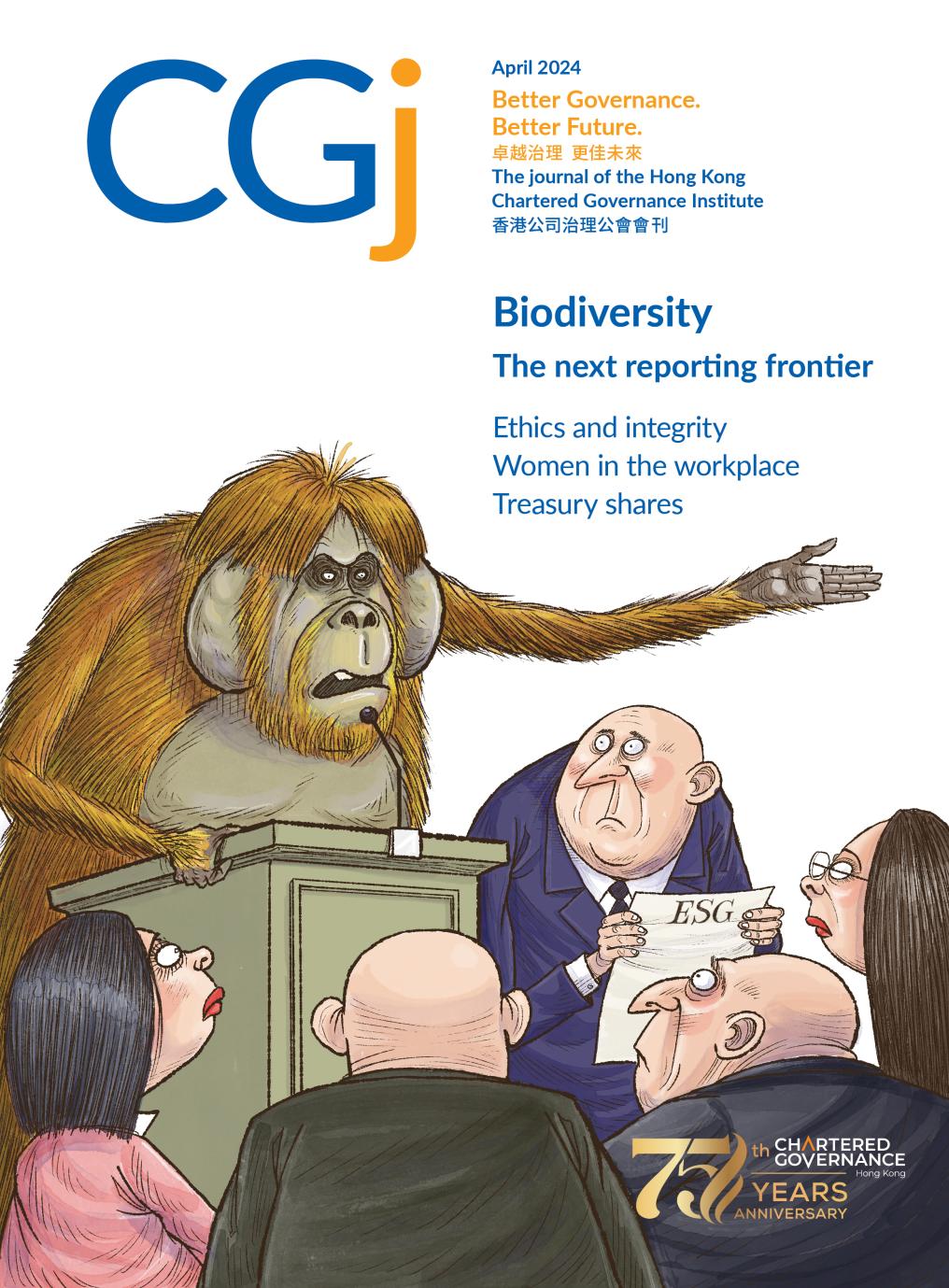Alexandra Tracy, President, Hoi Ping Ventures, looks at the growing focus of regulators and standard-setters on increasing transparency around companies’ impacts and exposures related to biodiversity and natural ecosystems.
Highlights
- the ISSB’s work on biodiversity and ecosystems will have significant influence on the future development of disclosure requirements in Asia
- many businesses are aware of the extent of biodiversity loss in general, but are struggling to understand their own impact and exposure
- while climate and biodiversity are directly connected, climate impacts are relatively easy to measure in terms of emissions levels and temperature changes, but biodiversity is a great deal more complex
In May 2023, the International Sustainability Standards Board (ISSB) launched a four-month consultation to seek comments on its priorities for its next two-year work plan. More than 400 responses were submitted and, while the ISSB is yet to announce its formal work plan for 2024–2025, it is clear in the feedback from market participants that there is robust support for a focus on biodiversity and ecosystems.
This sends a strong signal about the future direction of corporate reporting. The ISSB, which was launched in 2021 at the United Nations Climate Change Conference (COP26) in Glasgow, is an amalgam of standard-setters such as the Sustainability Accounting Standards Board, the Climate Disclosure Standards Board and the International Integrated Reporting Council, (now part of the IFRS Foundation), and is fast becoming the leading global reporting authority. Its inaugural standards for disclosure on sustainability and climate-related risks and opportunities, IFRS S1 and IFRS S2, have been widely welcomed by international regulatory bodies such as the International Organisation of Securities Commissions, governments, and leaders in the business and investor community.
This is equally the case in Asia. In Hong Kong, regulators have been working to align local disclosure standards with the ISSB standards. In 2023, Hong Kong Exchanges and Clearing Ltd (HKEX) launched its own consultation paper on proposals to enhance climate-related reporting requirements for Hong Kong listed companies, which was largely based on the ISSB’s draft climate-related disclosure standards of the year before. Following the end of the consultation period, HKEX announced recently that it would delay its updated requirement for mandatory climate disclosure to take into account the implementation of IFRS S1 and IFRS S2 globally.
It is very likely, therefore, that the ISSB’s work on biodiversity and ecosystems will have significant influence on the future development of disclosure requirements in the region.
Focus on nature
The heightened regulatory focus on nature reflects rapidly increasing demands by investors and environmental groups for information from companies about their impacts on biodiversity and natural habitats, and the consequent risks to their own businesses.
Recent research has highlighted the essential role of natural capital – the world’s stock of natural assets, from clean air and water to forests and coastlines, as well as animal and plant species – in supporting human economic activity. A leading report from the World Economic Forum in 2020 claimed that US$44 trillion of economic value generation – more than half of global GDP – is directly dependent on nature and its ecosystem services.
The accelerating rate in the loss of nature could have a devastating impact, especially in Asia, which is home to many unique species and nine of the world’s biodiversity hotspots. Across the region, natural ecosystems contribute 40% to regional GDP and 60% to employment, significantly more than the global average. Destruction of habitats and species could profoundly damage economic activities that rely on natural capital, threatening as much as 63% (US$19 trillion) of Asia’s GDP.
2023 – year of biodiversity
For some analysts, 2023 was the year when the world woke up to the scale of the risks potentially created by nature loss and started to take meaningful action to tackle them.
At the United Nations Biodiversity Conference (COP15) in late December 2022, a landmark global deal was reached to protect nature and to mobilise funding at scale for conservation. Nearly 200 countries at the conference confirmed the need to ‘halt and reverse biodiversity loss’ and put ‘nature on a pathway to recovery’. Under the Kunming–Montreal Global Biodiversity Framework (GBF), nations agreed an ambitious target to designate 30% of the world’s land and seas as protected areas by 2030, a goal known as ‘30 by 30’, as well as restoring 30% of degraded ecosystems. While the GBF is not a legally binding treaty, it is expected to have strong influence around the world, as countries endeavour to meet their targets with new plans and regulations, including more mandatory disclosure of relevant data.
Business was strongly represented at COP15, with more than 1,000 companies attending the conference, many of whom were new to the discussions around biodiversity. Among the announcements during the meetings, luxury fashion firm Kering and multinational beauty company L’Occitane Group launched a €300 million Climate Fund for Nature. The World Business Council for Sustainable Development, a global organisation of more than 200 leading companies, also announced a series of guidelines for businesses aiming to achieve a net positive impact on nature.
During 2023, investors also became more vocal about the need to ensure their holdings were addressing nature risks. By the end of the year, the Finance for Biodiversity Pledge, which commits financial institutions to protecting and restoring biodiversity through their investments and financing activities, had grown to over 160 signatories. While still relatively small in scale, a number of specialist funds have recently launched, such as RobecoSAM’s Biodiversity Equities fund and BNP Paribas Asset Management’s Ecosystem Restoration fund.
Beyond climate data
Since COP15, more companies have begun to work on strategies to limit their negative impacts on natural ecosystems and to identify the potential opportunities associated with investing in biodiversity initiatives. In many ways, the approaches by regulators and environmental groups to spur action in this area are similar to those used to encourage movement on climate change, which may explain why the discussion around biodiversity has gathered such momentum over the last year.
The difference is that, while climate and biodiversity are directly connected, climate impacts are relatively easy to measure in terms of emissions levels and temperature changes, but biodiversity is a great deal more complex. There is no single metric, like carbon emissions, and biodiversity is not spread evenly across the globe, as ecosystems are heterogenous and localised. The lack of historical baselines for nature also makes it significantly harder to measure and monitor.
As a result, while they may be aware of the extent of biodiversity loss in general, many businesses are struggling to understand their own impact and exposure. According to a report by the Capgemini Research Institute, only 24% of close to 2,000 executives surveyed said that their company has a biodiversity strategy. Most companies focus on climate change and consider biodiversity loss a longer-term risk.
Frameworks for nature
Consulting firm Bain & Company recommends that companies conduct a materiality and baseline assessment to determine their particular risks, impacts and dependencies on nature, which will provide the basis for their overall biodiversity strategy. This can be a challenging exercise, and there are already a bewildering number of measurement and reporting frameworks which aim to assist in the process. Among these, a few in particular seem to be gaining traction among regulators and businesses.
Science Based Targets Network (SBTN)
The SBTN, modelled on the work of the Science Based Targets initiative on climate, helps companies and local governments set time-bound, science-based and quantitative targets to reduce their impacts on nature and biodiversity. In May 2023, the SBTN released its first set of guidance documents on corporate standards for fresh water and land, which it will trial with a group of 17 companies (including AB InBev, LVMH, Nestlé, Tesco, Carrefour and the H&M Group) throughout the year. In the future, the SBTN expects to expand its coverage of land, fresh water, ocean and biodiversity targets, and to release additional guidance for businesses on implementing targets and tracking progress.
Taskforce on Nature-related Financial Disclosures (TNFD)
In September 2023, the TNFD published its long-awaited reporting and disclosure framework for nature-related dependencies, risks, impacts and opportunities. During a two-year design and development phase that included more than 200 pilot tests conducted by businesses and financial institutions, the organisation received feedback from over 60 countries. Building on the work of the Task Force on Climate-related Financial Disclosures, the recommended TNFD disclosures fall into four categories: governance, strategy, risk and impact management, and metrics and targets. Companies are advised to describe the governance structure and processes they use to assess, prioritise and monitor their nature-related exposures, set targets and devise action plans.
Global Reporting Initiative (GRI)
In January this year, GRI published a major update to its biodiversity standard, intended to support detailed, location-specific reporting, both within a company’s operations and throughout its supply chain. Incorporating new disclosures on land use, climate change, overexploitation, pollution and invasive species, as well as outcomes for local communities and indigenous peoples, the new standard aims to create greater transparency on how impacts on biodiversity are mitigated and reduced. Unlike other nature frameworks, which offer more flexibility, GRI’s standards define eight categories on which all businesses with significant biodiversity footprints must report. GRI will pilot the use of the updated framework over the next two years, with widespread use beginning in 2026.
Outlook for nature reporting
In the last few years, regulators and standard-setters have been working diligently to adapt the reporting infrastructure designed for climate to biodiversity. The numbers of policies, frameworks and tools being rapidly developed around the world can seem overwhelming for companies seeking to adapt to new requirements. A positive feature of recent developments is that there has been an overwhelming effort on the part of various organisations to collaborate and build on each other’s work. For example, the recommended TNFD disclosures announced in September last year incorporated the latest disclosure standards announced in July by ISSB. Similarly, in its updated framework, GRI collaborated closely with TNFD and SBTN experts to ensure that their guidance was aligned.
As the ISSB, in its turn, increases its focus on addressing nature and biodiversity, it is likely to move towards developing a global baseline that local jurisdictions can build on for their own reporting purposes. Regulators in Asia, including in Hong Kong, who have welcomed the ISSB’s initial standards on sustainability and climate, are likely to follow closely.
in the last few years, regulators and standard-setters have been working diligently to adapt the reporting infrastructure designed for climate to biodiversity
Alexandra Tracy, President
Hoi Ping Ventures



